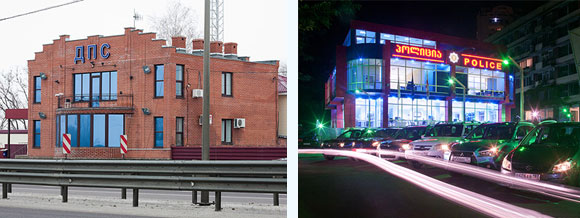Ekaterina Mishina describes the recent transgressions of the Russian police in Kazan, analyzes the successful police reform in Estonia and Georgia, and explains why the levels of public trust in the police achieved in those countries are impossible in Russia today.

March 14th, 2012. The news broadcast on Echo Moskvy. It is amazing how many terrible things can happen in the space of a single day. First, a report on the story of Sergey Nazarov, who died from after being tortured at the notorious Dalny police station in Kazan, the capital of Tatarstan (which is part of the Russian Federation). Then we hear about Aliya Sadykova, who also suffered at the hands of the Kazan police. Finally, the story of Kirill Vojdayed, a 19-year-old student detained at Domodedovo Airport in Moscow and taken to the police station on Bolshaya Cherkizovskaya Street, where he was also tortured.
Later in the day, the Kazan Human Rights Center and the Agora Human Rights Association release information on six more cases of illegal activities taking place at Kazan’s Dalny police station. What all of these horror stories illustrate is the deplorable state of police enforcement in Russia today, persisting despite the 2011 law on police reform, “On Police.” The Law ”On Police” clearly states that “the main function of the police shall be the protection of the life, health, rights, and freedoms of Russian citizens, foreign nationals, and the stateless” (Article 1, Part 1), and that “the police shall come to the immediate aid of any person in need of protection from criminal and other illegal offenses” (Article 1, Part 2).
The terrible offenses all over the news are routinely perpetrated by police officers who, according to the aforementioned law, “shall perform their duties in compliance and with respect toward human rights and freedoms” (Part 1 of Article 5). The same law envisages a strict prohibition against “the use of torture, violence, or other cruel or humiliating acts.” Moreover, Part 3 of Article 5 contains an unambiguously worded statement that “a policemen must refrain from any actions that intentionally cause an individual pain, physical or psychological suffering.” The lawlessness of the Russian police makes a mockery of such provisions. Is Russian police reform doomed? If so, it’s not for lack of positive examples. A number of countries have been successful in transforming a Soviet-style police force into modern law enforcement agency.
Estonia began reforming its police as soon as it gained its independence. At first the reforms seemed merely cosmetic: the district offices were renamed, but their internal structure remained the same. Some researchers believed that in the early 1990s, the main objective for reform would be changing police priorities, which in Soviet times were aimed more at protecting the state rather than the people. In the beginning of the reform period, the police continued to chiefly perform its putative functions. At the same time, police officers lost a number of job benefits such as housing and health insurance1.
In creating their new law enforcement agency, the Estonians followed the Finnish model of a non-militarized police that is a part of the Ministry of Interior. The major difference was that the new police force would treat people in a radically new way—with respect2. Estonia began by reducing the number of policemen, and by 2009, the number per capita was comparable with Scandinavian countries.
Despite the abolishment of the Soviet system, it took a long time for the public to restore their trust in the police. Many did not believe that a true transformation was possible.
The next stage of Estonian police reform came as part of the process of its integration into the European Union. First, the number of the district police departments was reduced to 4. The reformers thought that a Scandinavian-style system of territorial police departments whose jurisdiction doesn’t overlap with administrative regions would ensure lower levels of corruption than any centralized police system3. Upon dealing with quantity, the Estonians turned to quality, focusing on increasing police efficiency. In 2005, they launched the ePolice project. The main task of the project was providing policemen with better remote communications capabilities. The system provided for the hardware, information technologies, and communication solutions necessary for having instant coordination. All of these measures have proved very effective indeed and the system remains in place.
Today, the Estonian police force is up to European standards in every sense, including its mission: to provide a public service. The main evaluation criteria of the work of the Estonian police is the level of public trust. For this reason, the police maintains the utmost degree of transparency. Its website (www.politsei.ee) contains all of the information on their institutional structure and operations. The site also allows users to make electronic inquiries and follow the proceedings of criminal and administrative cases online. The Estonian police force is considered to be among the best in Europe. According to the results of the survey conducted by independent research company Turu-uuringute AS, in early 2011, 84% of respondents said they trusted the police.
The police force in Georgia is another outstanding example post-Soviet infrastructural reform gone right. Thanks to the efforts of a team assembled by President Mikheil Saakashvili, which began as soon as he came into power, the reforms were effected promptly, over the course of only three years. It is hard to believe that so much was accomplished in such a short time, especially considering that the Georgian police force was notorious for corruption during Soviet times.

Tbilisi. Document check
Photos by Dmitriy Chistoprudov
In 2004, the Georgian government liquidated the traffic police and laid off a large number of customs, financial, and law enforcement personnel. On August 15, 2004 the old traffic police was replaced by a new agency based on the US model for traffic patrol. Job openings in the newly-created agency were competitive, and the salaries were above the national average.










